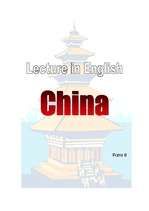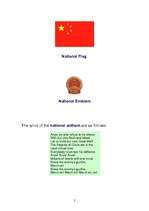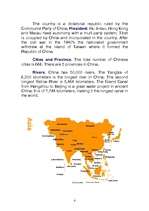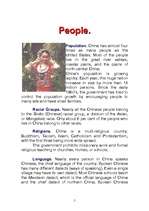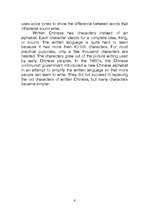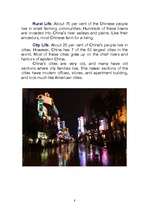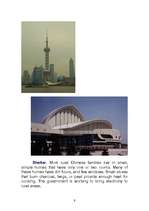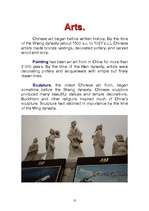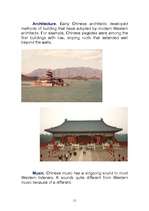China is a country in East Asia. The capital is Beijing. The third largest country in the world, next to Canada and Russia, it has an area of 9.6 million square kilometers. It begins from the confluence of the Heilong and Wusuli rivers in the east to the Pamirs west of Wuqia County in Xinjiang Uygur Autonomous Region in the west, about 5,200 kilometers apart; and from the midstream of the Heilong River north of Mohe in the north to the southernmost island Zengmu'ansha in the South China Sea, about 5,500 kilometers apart.
The country is a dictatorial republic ruled by the Communist Party of China. President: Hu Jintao. Hong Kong and Macau have autonomy with a multi-party system. Tibet is occupied by China and incorporated in the country. After the civil war in the 1940's the nationalist government withdrew at the island of Taiwan where it formed the Republic of China.
Cities and Province. The total number of Chinese cities is 666. There are 5 provinces in China.
Rivers. China has 50,000 rivers. The Yangtze of 6,300 kilometers is the longest river in China. The second longest Yellow River is 5,464 kilometers. The Grand Canal from Hangzhou to Beijing is a great water project in ancient China. It is of 1,794 kilometers, making it the longest canal in the world.
Population. China has almost four times as many people as the United States. Most of the people live in the great river valleys, coastal plains, and the plains of north-central China.
China’s population is growing rapidly. Each year, this huge nation increase in size by more than 14 million persons. Since the early 1960’s, the government has tried to control the population growth by encouraging people to marry late and have small families.
Racial Groups. Nearly all the Chinese people belong to the Sinitic (Chinese) racial group, a division of the Asian, or Mongoloid, race. Only about 6 per cent of the people who live in China belong to other races.
Religions. China is a multi-religious country. Buddhism, Taoism, Islam, Catholicism and Protestantism, with the first three being more wide spread.
The government prohibits missionary work and formal religious teaching in churches, homes, or schools.
Language. Nearly every person in China speaks Chinese, the chief language of the country. Spoken Chinese has many different dialects (ways of speaking). Even a single village may have its own dialect. Most Chinese schools teach the Mandarin dialect, which is the official language of China and the chief dialect of northern China. Spoken Chinese uses voice tones to show the difference between words that otherwise sound alike.
Iedzīvotāji. Ķīnai ir 4 reizes vairāk iedzīvotāju nekā Savienotajās Valstīs. Vairums cilvēku dzīvo lielo upju ielejās, piekrastes līdzenumos un ziemeļ-centrālās Ķīnas līdzenumos.
Ķīnas iedzīvotāju skaits strauji pieaug. Katru gadu šīs milzu nācijas apmērs pieaug par vairāk nekā 14 miljoniem cilvēku. Kopš 1960. g. sākuma valdība cenšas kontrolēt iedzīvotāju pieaugumu, pamudinot cilvēkus precēties vēlāk un veidot mazas ģimenes.
Rasu grupas. Gandrīz visa ķīniešu tauta pieder Sinitic (ķīniešu) rasu grupai, aziātu vai mongoloīdu izcelsmes daļai. Tikai apmēram 6 procenti cilvēku, kas dzīvo Ķīnā pieder citām rasēm.
…
Map of China; People; Way of Life; Arts; Technology. Referāts angļu valodā ar krāsainiem attēliem un pielikumā tā daļēju tulkojumu latviešu valodā.

